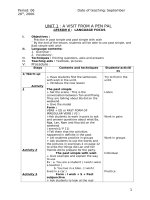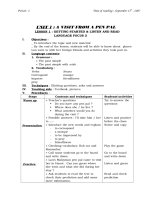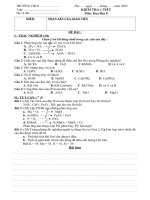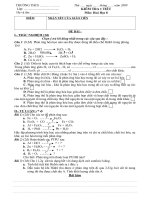Vietnam War Biographies.Volume 1: A–K pptx
Bạn đang xem bản rút gọn của tài liệu. Xem và tải ngay bản đầy đủ của tài liệu tại đây (2.89 MB, 239 trang )
Biographies
Vietnam War
VW-BioV1.tpgs 9/29/03 2:59 PM Page 1
Biographies
Kevin Hillstrom
and Laurie Collier
Hillstrom
Diane Sawinski, Editor
Vietnam War
Volume 1: A–K
VW-BioV1.tpgs 9/29/03 2:59 PM Page 3
Reader’s Guide ix
Vietnam War Timeline xiii
Words to Know xxv
Volume 1: A-K
Spiro T. Agnew 1
Joan Baez 7
Daniel Berrigan 15
McGeorge Bundy 24
William Calley 30
Ramsey Clark 38
Richard J. Daley 45
David Dellinger 52
Jeremiah Denton 58
Daniel Ellsberg 64
Diane Carlson Evans 73
Bernard Fall 79
Frances FitzGerald 87
Jane Fonda 92
v
Contents
VWBioFM.qxp 7/30/03 1:55 PM Page v
J. William Fulbright 98
Barry Goldwater 105
David Halberstam 113
Tom Hayden 119
Michael Herr 127
Ho Chi Minh 134
Abbie Hoffman 141
Lyndon B. Johnson 148
John F. Kennedy 165
Robert F. Kennedy 174
Martin Luther King, Jr. 181
Henry A. Kissinger 189
Ron Kovic 196
Where to Learn More xxxiii
Index xliii
Volume 2: L-Z
Edward Lansdale 203
Le Duan 210
Le Duc Tho 215
Le Ly Hayslip 224
Maya Lin 230
Henry Cabot Lodge 237
Lon Nol 243
Graham Martin 249
John McCain 257
George McGovern 265
Robert McNamara 272
Bobby Muller 281
Ngo Dinh Diem 288
Madame Ngo Dinh Nhu (Tran Le Xuan) 296
Nguyen Cao Ky 303
Nguyen Thi Dinh 311
Nguyen Van Thieu 316
Richard M. Nixon 323
Tim O’Brien 332
Tim Page 339
Pham Van Dong 346
Phan Thi Kim Phuc 352
Pol Pot 359
vi Vietnam War: Biographies
VWBioFM.qxp 7/30/03 1:55 PM Page vi
Dean Rusk 369
Jan Scruggs 375
Neil Sheehan 382
Norodom Sihanouk 389
Souvanna Phouma 396
Oliver Stone 400
Maxwell Taylor 406
Lynda Van Devanter 413
Vo Nguyen Giap 421
William Westmoreland 429
Where to Learn More xxxiii
Index xliii
Contents vii
VWBioFM.qxp 7/30/03 1:55 PM Page vii
V
ietnam War: Biographies presents biographies of sixty men
and women who participated in or were affected by the
Vietnam War. These two volumes profile a diverse mix of per-
sonalities from both the United States and Vietnam, including
politicians, military leaders, antiwar activists, journalists,
authors, nurses, veterans, and civilians who got caught in the
middle of the conflict.
Detailed biographies of major Vietnam War figures
(such as Ho Chi Minh, Lyndon B. Johnson, Robert McNamara,
Ngo Dinh Diem, and Richard M. Nixon) are included. But Viet-
nam War: Biographies also provides biographical information
on lesser-known but nonetheless important and fascinating
men and women of that era. Examples include Daniel Berri-
gan, a Catholic priest who went to prison for burning military
draft files as a form of protest against the war; Jeremiah Den-
ton, an American prisoner-of-war who blinked the word “tor-
ture” in Morse code during a televised interview with his
North Vietnamese captors; Tim Page, a daring British combat
photographer who produced some of the best known images
of the war before being seriously wounded; Phan Thi Kim
ix
Reader’s Guide
VWBioFM.qxp 7/30/03 1:55 PM Page ix
Phuc, a nine-year-old Vietnamese girl who was photographed
running naked down a country road after suffering terrible
burns from a U.S ordered napalm attack in her village; and Jan
Scruggs, an American veteran who led the drive to create the
Vietnam Veterans Memorial in Washington, D.C.
Vietnam War: Biographies also features sidebars con-
taining interesting facts, excerpts from memoirs, diaries, and
speeches, and short biographies of people who are in some
way connected with the leading figures of the era. Within each
full-length biography, cross-references direct readers to other
individuals profiled in the two-volume set. More than seventy
black and white photographs enhance the text. In addition,
each volume contains a timeline that lists significant dates and
events of the Vietnam War era, a glossary, further readings, and
a cumulative subject index.
Vietnam War Reference Library
Vietnam War: Biographies is only one component of the
three-part U•X•L Vietnam War Reference Library. The other
two titles in this set are:
• Vietnam War: Almanac: This work presents a comprehen-
sive overview of the Vietnam War. The volume’s sixteen
chapters cover all aspects of the conflict, from the reasons
behind American involvement, to the antiwar protests
that rocked the nation, to the fall of Saigon to Communist
forces in 1975. The chapters are arranged chronologically
and explore such topics as Vietnam’s struggles under
French colonial rule, the introduction of U.S. combat
troops in 1965, the Tet Offensive, and the lasting impact of
the war on both the United States and Vietnam. Inter-
spersed are four chapters that cover the growth of the
American antiwar movement, the experiences of U.S. sol-
diers in Vietnam, Vietnam veterans in American society,
and the effect of the war on Vietnam’s land and people.
The Almanac also contains “Words to Know” and “People
to Know” sections, a timeline, research and activity ideas
and a subject index.
• Vietnam War: Primary Sources: This title presents thirteen
full or excerpted speeches and written works from the Viet-
nam War era. The volume includes excerpts from civil
xVietnam War: Biographies
VWBioFM.qxp 7/30/03 1:55 PM Page x
rights leader Martin Luther King, Jr.’s 1967 antiwar speech
at Riverside Church in New York City; President Richard
Nixon’s 1969 “Silent Majority” speech; Le Ly Hayslip’s
memoir When Heaven and Earth Changed Places, about
growing up in a war-torn Vietnamese village and becom-
ing involved with the Viet Cong; and Admiral James Stock-
dale’s memoir about his years in a Vietnamese prisoner-of-
war camp, In Love and War. Each entry includes an
introduction, things to remember while reading the
excerpt, information on what happened after the work was
published or the event took place, and other interesting
facts. Photographs, source information, and an index sup-
plement the work.
•A cumulative index of all three titles in the U•X•L Vietnam
War Reference Library is also available.
Acknowledgments
The authors extend thanks to U•X•L Senior Editor Diane
Sawinski and U•X•L Publisher Tom Romig at the Gale Group for
their assistance throughout the production of this series.
Comments and Suggestions
We welcome your comments on Vietnam War: Biogra-
phies and suggestions for other topics in history to consider.
Please write: Editors, Vietnam War: Biographies, U•X•L, 27500
Drake Rd., Farmington Hills, Michigan 48331-3535; call toll-
free 800-877-4253; fax to 248-414-5043; or send e-mail via
.
Reader’s Guide xi
VWBioFM.qxp 7/30/03 1:55 PM Page xi
1862 Under the Treaty of Saigon, Vietnam gives control of
three eastern provinces to France.
1863 France makes Cambodia a French colony.
1883 Under the Treaty of Hue, France expands its control
over all of Vietnam.
1887 France turns its holdings in Southeast Asia into one
colony, called Indochina.
1893 France makes Laos a French colony.
1930 Ho Chi Minh creates the Indochinese Communist
Party to oppose French colonial rule.
1940 Japan occupies Indochina during World War II.
xiii
Vietnam War Timeline
1861–65
U.S. Civil
War
1890
The Battle of Wounded
Knee ends the last
major Indian resistance
to white settlement
in America
1929
Onset of the
Great
Depression
1939–45
World
War II
1860 1900 1940
VWBioFM.qxp 7/30/03 1:55 PM Page xiii
1950
Korean War
begins
1941 The Communist-led Vietnamese nationalist organiza-
tion known as the Viet Minh is established.
March 1945 Emperor Bao Dai proclaims Vietnam an inde-
pendent nation under Japan’s protection.
April 1945 U.S. president Franklin Roosevelt dies; Harry S.
Truman takes office.
August 1945 Japan surrenders to end World War II.
August 1945 Bao Dai is removed from power in the August
Revolution.
September 1945 Ho Chi Minh establishes the Democratic
Republic of Vietnam and declares himself president.
September 1945 U.S. Army Major A. Peter Dewey becomes
the first American soldier to die in Vietnam.
March 1946 France declares Vietnam an independent state
within the French Union.
November 1946 The First Indochina War begins with a Viet
Minh attack on French forces in Hanoi.
1949 France creates the independent State of Vietnam under
Bao Dai.
January 1950 Communist countries China, Yugoslavia, and
the Soviet Union formally recognize the Democratic
Republic of Vietnam under Ho Chi Minh.
February 1950 Democratic countries Great Britain and the
United States formally recognize the State of Vietnam
under Bao Dai.
May 1950 The United States begins providing military and
economic aid to French forces in Vietnam.
June 1950 Truman sends U.S. troops into Korea to begin the
Korean War.
xiv Vietnam War: Biographies
1946
The Cold War
between the United
States and the Soviet
Union begins
1944
Anne Frank and family are
captured by the Nazis after
two years in hiding and
taken to the concentration
camp at Auschwitz
1949
People’s Republic
of China proclaimed
by Mao Tse-tung
Ho Chi Minh.
1942 1946 1950
VWBioFM.qxp 7/30/03 1:55 PM Page xiv
1952 Dwight Eisenhower becomes president of the United
States.
1954 An estimated one million Vietnamese flee North Viet-
nam for South Vietnam. Many credit Edward Lansdale,
a secret agent for the U.S. Central Intelligence Agency
(CIA), as a key reason for this mass exodus.
March 1954 The Viet Minh set up a siege of the French out-
post at Dien Bien Phu.
May 1954 Viet Minh forces defeat the French in the Battle of
Dien Bien Phu.
June 1954 Bao Dai selects Ngo Dinh Diem as prime minister
of the State of Vietnam.
July 1954 The Geneva Accords divide Vietnam into two sec-
tions: North Vietnam, led by Communists under Ho
Chi Minh; and South Vietnam, led by a U.S supported
government under Ngo Dinh Diem.
July 1954 Laos and Cambodia are granted full independence
from France.
October 1954 French troops are withdrawn from Vietnam.
July 1955 Ngo Dinh Diem refuses to proceed with national
elections required by the Geneva Accords.
September 1955 Cambodia gains independence from France;
Norodom Sihanouk becomes prime minister.
October 1955 Diem takes control of the South Vietnamese
government from Bao Dai and establishes the Republic
of Vietnam.
1957 Communist rebels begin fighting for control of
South Vietnam.
1959 Construction begins on the Ho Chi Minh Trail, a major
supply and communications route for Communist
forces.
Timeline xv
1956
Soviet troops
suppress a
revolution in
Hungary
1953
James Watson
and Francis Crick
decipher the
structure of DNA
1954
Egypt and Britain
conclude a pact on
the Suez Canal, ending
72 years of British
military occupation
1959
Ruth and Eliot
Handler, owners
of Mattel, unveil
the Barbie Doll
1953 1956 1959
VWBioFM.qxp 7/30/03 1:55 PM Page xv
1960 Le Duan is elevated to secretary general of the Com-
munist Party, making him one of the most powerful
men in North Vietnam during the Vietnam War.
November 1960 Rebels try to overthrow the Diem government.
November 1960 John F. Kennedy becomes president of the
United States.
November 1960 The National Liberation Front is established
in North Vietnam to overthrow Diem and reunite the
two parts of Vietnam.
1961 Kennedy offers military assistance to Diem and sends
the first U.S. advisors to South Vietnam.
January 1963 The Battle of Ap Bac brings American public
attention to Vietnam.
April 1963 Buddhists begin demonstrating against the Diem
government.
June 1963 The suicide of a Buddhist monk draws interna-
tional attention to the situation in Vietnam.
September 1963 President Kennedy sends military advisor
Maxwell Taylor and Secretary of Defense Robert McNa-
mara to Vietnam to conduct a study of the escalating
situation between South Vietnam and the Viet Cong.
November 1963 Ngo Dinh Diem and other members of his
government are assassinated; the Military Revolution-
ary Council takes control of South Vietnam.
November 1963 President Kennedy is assassinated; Lyndon
Johnson takes office.
July 1964 Senator Barry Goldwater loses to Lyndon Johnson
in one of the most lopsided presidential elections in
American history.
August 1964 North Vietnamese patrol boats reportedly attack
American warships in the Gulf of Tonkin.
xvi Vietnam War: Biographies
Lyndon B. Johnson.
Reproduced by permission
of AP/Wide World Photos.
Robert McNamara.
Reproduced by permission of
AP/Wide World Photos.
1960
Theodore Maiman
builds the first
working laser
1961
CIA-backed invasion
of Cuba at the
Bay of Pigs
1962
Television satellite
Telstar put into orbit
by U.S.A.
1960 1961 1962
VWBioFM.qxp 7/30/03 1:55 PM Page xvi
August 1964 The U.S. Congress passes the Gulf of Tonkin Res-
olution, which allows Johnson to use any means nec-
essary to prevent North Vietnamese aggression.
November 1964 Johnson is reelected as president of the
United States.
1965 Nguyen Thi Dinh is named deputy commander of the
Communist-led National Liberation Front (NLF)
armed forces, which is the highest combat position
held by a woman during the Vietnam War.
February 1965 Viet Cong guerillas attack a U.S. base at Pleiku;
the U.S. military retaliates with air attacks.
March 1965 The American bombing campaign known as
Operation Rolling Thunder begins over North Vietnam.
March 1965 The first U.S. combat troops are sent to Vietnam.
March 1965 Faculty of the University of Michigan organize a
teach-in to protest the war.
June 1965 Nguyen Cao Ky becomes premier of South Vietnam.
August 1965 Henry Cabot Lodge is appointed as American
ambassador to South Vietnam.
November 1965 Antiwar demonstrations become widespread
in the United States.
1966 U.S. national security advisor McGeorge Bundy resigns
from office due to doubts about U.S. policy toward
Vietnam.
1966 American prisoner-of-war Jeremiah Denton blinks
“torture” in Morse code during a televised interview
with his North Vietnamese captors.
January 1966 Senator J. William Fulbright arranges for the
Senate Foreign Relations Committee to hold public
hearings on American military involvement in Viet-
Timeline xvii
1965
Former British prime
minister Winston
Churchill dies
1964
The Civil Rights Act, which forbids
employers and other businesses
from discriminating against
minorities, is signed into law
1963
Freedom March held
in Washington, D.C.
1963 1964 1965
VWBioFM.qxp 7/30/03 1:55 PM Page xvii
nam. The hearings are widely credited with increasing
public skepticism about the Johnson administration’s
handling of the Vietnam War.
February 1967 French journalist Bernard Fall is killed by a
land mine while covering the war in Vietnam.
April 1967 Civil rights leader Martin Luther King, Jr., speaks
out against the Vietnam War.
September 1967 Nguyen Van Thieu becomes president of
South Vietnam.
October 1967 The March on the Pentagon draws 50,000 anti-
war protesters to Washington, D.C.
October 1967 Navy pilot John McCain’s fighter plane is shot
down over Hanoi. He becomes a prisoner-of-war
(POW) for more than five years in North Vietnam.
January 1968 The Siege of Khe Sanh begins.
January 1968 North Vietnamese forces, headed up by Vo
Nguyen Giap, launch the Tet Offensive.
January 1968 The Battle for Hue begins.
February 1968 Clark Clifford replaces Robert McNamara as
U.S. secretary of defense.
March 1968 U.S. troops kill hundreds of Vietnamese civilians
in the My Lai Massacre.
March 1968 Johnson announces he will not seek reelection.
April 1968 Civil rights leader Martin Luther King, Jr., is assas-
sinated.
May 1968 The United States and North Vietnam begin peace
negotiations in Paris.
May 1968 Catholic priest Daniel Berrigan burns military
draft files in Catonsville, Maryland, to protest the
Vietnam War.
xviii Vietnam War: Biographies
1967
Dr. Christiaan Barnard
performs the first
human heart transplant
1967
Rolling Stone
magazine begins
publication
Martin Luther King, Jr.
Reproduced by permission of
National Archives and Records.
Robert F. Kennedy.
Library of Congress.
1966
Cultural Revolution
begins in China
1968
Ralph Lauren
introduces his Polo
line of clothing
1966 1967 1968
VWBioFM.qxp 7/30/03 1:55 PM Page xviii
June 1968 U.S. senator and Democratic presidential candi-
date Robert F. Kennedy is assassinated.
June 1968 William Westmoreland is relieved of his command
over U.S. troops in Vietnam.
August 1968 Antiwar protestors disrupt the Democratic
National Convention in Chicago. Chicago police, under
the leadership of Chicago mayor Richard J. Daley, are crit-
icized for their use of violence to quiet angry protestors.
October 1968 Johnson announces an end to the bombing of
North Vietnam.
November 1968 Richard M. Nixon is elected president of the
United States.
January 1969 Former U.S. attorney general Ramsey Clark
leaves office and becomes an outspoken member of
the antiwar movement.
February 1969 Secret bombing of Cambodia begins.
April 1969 U.S. troop levels in Vietnam peak at 543,400.
June 1969 Nixon puts his “Vietnamization” policy into effect,
reducing U.S. troop levels by 25,000.
September 1969 North Vietnamese leader Ho Chi Minh dies.
September 1969 The “Chicago Seven” trial begins, in which
David Dellinger, Abbie Hoffman, Tom Hayden, and
other prominent antiwar activists are charged with
conspiracy for disrupting the Democratic National
Convention.
April 1970 Lon Nol seizes power from Norodom Sihanouk in
Cambodia.
April 1970 Nixon authorizes American troops to invade
Cambodia.
Timeline xix
July 1969
U.S. astronaut Neil
Armstrong becomes
the first man to walk
on the moon
August 1969
Woodstock
Music Fair
attracts three
hundred
thousand people
1970
Television and radio
cigarette ads are
banned in the U.S.
1971
Greenpeace founded
in Vancouver,
Canada
William Westmoreland.
Reproduced by permission of
Archive Photos.
Abbie Hoffman.
Library of Congress.
1969 1970 1971
VWBioFM.qxp 7/30/03 1:55 PM Page xix
May 1970 The National Guard kills four student protestors
during an antiwar demonstration at Kent State Uni-
versity in Ohio.
June 1970 U.S. troops withdraw from Cambodia.
October 1970 Antiwar groups hold the first Moratorium Day
protests.
November 1970 Nixon makes his “Silent Majority” speech.
November 1970 The My Lai Massacre is revealed to the Amer-
ican people.
November 1970 Lt. William Calley is put on trial for his role
in the My Lai Massacre.
December 1970 The U.S. Congress repeals the Tonkin Gulf
Resolution.
February 1971 Daniel Ellsberg leaks the top-secret Pentagon
Papers to reporter Neil Sheehan.
June 1971 The New York Times begins publishing the Penta-
gon Papers.
1972 Actress Jane Fonda makes a controversial visit to North
Vietnam.
1972 American journalist Frances FitzGerald publishes Fire
in the Lake, which looks at the war from a Vietnamese
perspective.
1972 American journalist David Halberstam publishes The
Best and the Brightest, about the U.S. officials who
developed the government’s policy toward Vietnam.
March 1972 North Vietnamese troops, under the leadership
of Vo Nguyen Giap, begin the Easter Offensive.
June 1972 Republican agents associated with Nixon break
into the Democratic presidential campaign headquar-
ters at the Watergate Hotel in Washington, D.C.
xx Vietnam War: Biographies
1971
The Twenty-sixth
Amendment, which
lowers U.S. voting age
from 21 to 18, is ratified
1973
Artist Pablo Picasso dies
1972
President Nixon makes
historic visit to China
Bobby Seale.
Reproduced by permission of
AP/Wide World Photos.
Vo Nguyen Giap.
Reproduced by permission of
Archive Photos.
1971 1972 1973
VWBioFM.qxp 7/30/03 1:55 PM Page xx
August 1972 The last U.S. combat troops withdraw from Viet-
nam.
November 1972 Nixon is reelected as president after defeat-
ing Democratic nominee George McGovern.
December 1972 U.S. warplanes begin the Christmas bombing
campaign.
January 1973 The United States and North Vietnam sign the
Paris Peace Accords.
February 1973 North Vietnam releases American prisoners of
war (POWs).
June 1973 The U.S. Congress passes the Case-Church Amend-
ment, prohibiting further American military involve-
ment in Southeast Asia.
October 1973 Spiro T. Agnew resigns as vice president of the
United States.
October 1973 North Vietnamese negotiator Le Duc Tho and
U.S. secretary of state Henry Kissinger are awarded the
Nobel Peace Prize.
November 1973 The U.S. Congress passes the War Powers Act
over Nixon’s veto, reducing the president’s authority
to commit U.S. military forces.
August 1974 Threatened with impeachment over the Water-
gate scandal, Nixon resigns from office; Gerald R. Ford
becomes president of the United States.
September 1974 President Ford pardons Richard Nixon.
March 1975 North Vietnamese forces capture Hue, Da Nang,
and other South Vietnamese cities.
March 1975 President Nguyen Van Thieu orders South Viet-
namese forces to withdraw from the central provinces,
causing the “Convoy of Tears.”
Timeline xxi
1975
Bill Gates organizes
Microsoft Corp.
1976
Viking I and Viking II
space probes land
on Mars
1974
Anthropologists discover “Lucy,”
a hominid skeleton more than
three million years old
1974 1975 1976
VWBioFM.qxp 7/30/03 1:55 PM Page xxi
1977
Steven Jobs and
Steve Wozniak
found the Apple
Computer Co.
1980
Former Beatle
John Lennon is
shot and killed
April 1975 The U.S. embassy in Saigon is evacuated by mili-
tary helicopters.
April 1975 North Vietnamese forces capture the South Viet-
namese capital of Saigon to win the Vietnam War.
April 1975 Communist Khmer Rouge rebels capture the capi-
tal of Phnom Penh and take control of Cambodia.
May 1975 Khmer Rouge forces capture the U.S. merchant ship
Mayaguez.
August 1975 The Communist-led Pathet Lao take control of
Laos, removing prime minister Souvanna Phouma
from rule.
1976 Vietnam veteran Ron Kovic publishes his memoir Born
on the Fourth of July.
July 1976 Vietnam is reunited as one country under Commu-
nist rule, called the Socialist Republic of Vietnam.
Pham Van Dong becomes premier of the newly formed
country.
November 1976 Jimmy Carter is elected president of the
United States.
1977 Carter pardons most Vietnam War draft evaders.
1977 Journalist Michael Herr publishes Dispatches, based on
his experiences reporting on the war in Vietnam.
1978 Thousands of refugees known as “boat people” flee
from Vietnam, creating an international crisis.
1978 Vietnam invades Cambodia and takes control of the
government away from the violent Khmer Rouge.
1978 Veteran Bobby Muller cofounds the support organiza-
tion Vietnam Veterans of America.
1979 China reacts to the Vietnamese invasion of Cambodia
by invading northern Vietnam.
xxii Vietnam War: Biographies
1978
U.S. Senate ratifies
Panama Canal
Agreement
1979
Political action group
“Moral Majority” is
founded by Jerry Falwell
Joan Baez.
Reproduced by permission
of Jack Vartoogian.
1977 1978 1979 1980
VWBioFM.qxp 7/30/03 1:55 PM Page xxii
1979 Vietnam veteran Jan Scruggs cofounds the Vietnam
Veterans Memorial Fund (VVMF).
1979 Joan Baez forms a group called Humanitas to raise
money for food and medical supplies for the many
refugees from Vietnam, Cambodia, and Laos in refugee
camps in northern Thailand.
1980 Ronald Reagan is elected president of the United States.
1980 U.S. Army nurse Lynda Van Devanter founds the Viet-
nam Veterans of America Women’s Project to assist
female veterans.
1982 The Vietnam Veterans Memorial, designed by Maya
Lin, is dedicated in Washington, D.C.
1983 Photojournalist Tim Page publishes Tim Page’s Nam, a
collection of his best known images of the war.
1984 American Vietnam veterans reach an out-of-court set-
tlement with chemical companies over health prob-
lems related to their wartime exposure to the poiso-
nous herbicide Agent Orange.
1984 Diane Carlson Evans founds the Vietnam Women’s
Memorial Project to raise funds for a memorial for
female veterans.
1986 Nguyen Van Linh becomes head of the Communist
Party in Vietnam and introduces the Doi Moi economic
reforms.
1986 Platoon, the award-winning film about a young Amer-
ican soldier in Vietnam, is released. It is directed by
Vietnam veteran Oliver Stone.
1988 George Bush becomes president of the United States.
1988 Reporter Neil Sheehan publishes A Bright Shining Lie:
John Paul Vann and America in Vietnam.
Timeline xxiii
1981
Acquired Immune
Deficiency virus
(AIDS) is identified
1988
Colin Powell
becomes first black
4-star general in
U.S. Army
1984
Olympic Games at Los
Angeles, California, are
boycotted by Soviet
bloc countries
1986
U.S. space shuttle
Challenger explodes seconds
after takeoff, killing seven
astronauts including teacher
Christa McAuliffe
Lynda Van Devanter.
Reproduced by permission
of AP/Wide World Photos.
Diane Carlson Evans.
Reproduced by permission
of AP/Wide World Photos.
1982 1984 1986 1988
VWBioFM.qxp 7/30/03 1:55 PM Page xxiii
1989 Vietnam withdraws its troops from Cambodia.
1989 Le Ly Hayslip publishes When Heaven and Earth
Changed Places, her memoir about growing up in South
Vietnam during the Vietnam War.
1990 Tim O’Brien publishes The Things They Carried, which
is regarded as the single greatest work of literature ever
written about the American experience in Vietnam.
1992 Bill Clinton is elected president of the United States.
1993 The United Nations sponsors free elections in Cambo-
dia; Norodom Sihanouk regains his position as king.
1993 The Vietnam Women’s Memorial is dedicated in Wash-
ington, D.C.
1993 Nguyen Thi Binh, the second-ranking negotiator for
the North Vietnamese side in the Paris peace talks, is
elected vice president of Vietnam.
1994 President Clinton ends the economic embargo against
trade with Vietnam.
1995 The United States restores full diplomatic relations
with Vietnam.
1995 Former secretary of defense Robert McNamara pub-
lishes In Retrospect, in which he reveals his personal
doubts about U.S. actions in Vietnam.
1998 Pol Pot, former leader of the Cambodian Communists
known as the Khmer Rouge, dies under mysterious cir-
cumstances.
xxiv Vietnam War: Biographies
1993
North American Free
Trade Agreement
(NAFTA) is signed
1997
U.S. diplomat
Madeline
Albright becomes
the first woman
secretary of state
1998
President Bill
Clinton is
impeached by
the House of
Representatives
1990
Mikhail Gorbachev,
president of the Soviet
Union, is awarded the
Nobel Peace Prize
Le Ly Hayslip.
Reproduced by permission
of AP/Wide World Photos.
Nguyen Thi Binh.
Reproduced by permission
of Corbis Corporation.
1990 1993 1996 1999
VWBioFM.qxp 7/30/03 1:55 PM Page xxiv
A
ARVN: The South Vietnamese army, officially known as the
Army of the Republic of South Vietnam. The ARVN
fought on the same side as U.S. troops during the Viet-
nam War.
B
Buddhism: A religion based on the teaching of Gautama Bud-
dha, in which followers seek moral purity and spiritual
enlightenment.
C
Cambodia: Southeast Asian nation located on the western
border of South Vietnam. During the Vietnam War,
Cambodia experienced its own civil war between its
pro-U.S. government forces and Communist rebels
known as the Khmer Rouge.
xxv
Words to Know
VWBioFM.qxp 7/30/03 1:55 PM Page xxv
Cold War: A period of intense rivalry between the United States
and the Soviet Union as both nations competed to
spread their political philosophies and influence around
the world after the end of World War II. The climate of
distrust and hostility between the two nations and their
allies dominated international politics until the 1980s.
Colonialism: A practice in which one country assumes politi-
cal control over another country. Most colonial powers
established colonies in foreign lands in order to take
possession of valuable natural resources and increase
their own power. They often showed little concern for
the rights and well-being of the native people.
Communism: A political system in which the government
controls all resources and means of producing wealth.
By eliminating private property, this system is
designed to create an equal society with no social
classes. However, Communist governments in practice
often limit personal freedom and individual rights.
Coup d’etat: A sudden, decisive attempt to overthrow an exist-
ing government.
D
Dien Bien Phu: A French fort in northwestern Vietnam that was
the site of a major battle in the Indochina War in 1954.
Domino Theory: A political theory that held that the fall of
one country’s government to communism usually trig-
gered similar collapses in neighboring countries, as if
the nations were dominoes falling in sequence.
E
Escalation: A policy of increasing the size, scope, and intensity
of military activity.
G
Great Society: A set of social programs proposed by President
Lyndon Johnson designed to end segregation and
reduce poverty in the United States.
xxvi Vietnam War: Biographies
VWBioFM.qxp 7/30/03 1:55 PM Page xxvi
Guerrilla: A member of a native military force operating in
small units in occupied territory to harass the enemy,
often with surprise attacks.
H
Hanoi: The capital city of Communist North Vietnam. Also an
unofficial shorthand way of referring to the North
Vietnamese government.
I
Indochina: The name sometimes given to the peninsula
between India and China in Southeast Asia. The term
narrowly refers to Cambodia, Laos, and Vietnam,
which were united under the name French Indochina
during the colonial period, 1893-1954.
Indochina War: Later known as the First Indochina War (the
Vietnam War became the Second Indochina War), this
conflict took place between France and Communist-
led Viet Minh forces in Vietnam, 1946-54.
K
Khmer Rouge: Communist-led rebel forces that fought for
control of Cambodia during the Vietnam War years.
The Khmer Rouge overthrew the U.S backed govern-
ment of Lon Nol in 1975.
L
Laos: A Southeast Asian nation located on the western bor-
der of North Vietnam. During the Vietnam War, Laos
experienced its own civil war between U.S backed
forces and Communist rebels known as the Pathet Lao.
M
MIAs: Soldiers classified as “missing in action,” meaning that
their status is unknown to military leaders or that their
bodies have not been recovered.
Words to Know xxvii
VWBioFM.qxp 7/30/03 1:55 PM Page xxvii
Military Revolutionary Council: A group of South Viet-
namese military officers that overthrew President Ngo
Dinh Diem and took control of South Vietnam’s gov-
ernment in 1963.
N
Nationalism: A feeling of intense loyalty and devotion to a
country or homeland. Some people argued that
nationalism, rather than communism, was the main
factor that caused the Viet Minh to fight the French for
control of Vietnam.
North Vietnam: The Geneva Accords of 1954, which ended
the First Indochina War, divided the nation of Vietnam
into two sections. The northern section, which was led
by a Communist government under Ho Chi Minh, was
officially known as the Democratic Republic of Viet-
nam but was usually called North Vietnam.
NVA: The North Vietnamese Army, which assisted the Viet
Cong guerilla fighters in trying to conquer South Viet-
nam. These forces opposed the United States in the
Vietnam War.
O
Offensive: A sudden, aggressive attack by one side during a war.
P
Paris Peace Accords: A peace agreement, signed on January
25, 1973, between the United States and North Viet-
nam that ended direct American involvement in the
Vietnam War.
Pentagon Papers: A set of secret U.S. Department of Defense
documents that explained American military policy
toward Vietnam from 1945 to 1968. They created a
controversy when they were leaked to the national
media in 1971.
Post-Traumatic Stress Syndrome (PTSS): A set of psychologi-
cal problems that are caused by exposure to a danger-
xxviii Vietnam War: Biographies
VWBioFM.qxp 7/30/03 1:55 PM Page xxviii









